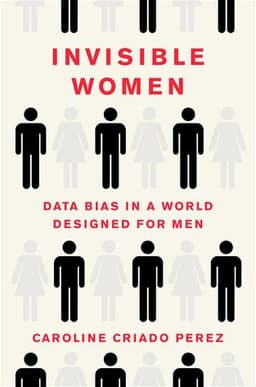
Invisible Women - 1 Minute Summary
Data Bias in a World Designed for Men
Book by Caroline Criado Perez
Read the In-Depth 15 Minute Summary
Unveiling the Hidden Gender Bias in Our World: Lessons from "Invisible Women"
In her groundbreaking book "Invisible Women: Data Bias in a World Designed for Men," Caroline Criado Perez exposes a pervasive yet often overlooked problem: the gender data gap. This gap refers to the lack of data collected on women's lives, experiences, and needs, which leads to a world designed primarily for men. From healthcare to transportation, from technology to public policy, the failure to consider women's perspectives and requirements results in a society that systematically disadvantages and discriminates against half of its population.
The "invisible women" phenomenon is not a mere oversight but a deeply ingrained bias that stems from centuries of male-dominated decision-making. Criado Perez argues that this bias is perpetuated by the assumption that men are the default human, and that their needs and experiences are universal. As a result, women are often treated as atypical or even abnormal, and their specific needs are neglected or ignored. This lack of consideration for women's lives has far-reaching consequences, from the minor inconveniences of ill-fitting personal protective equipment to the life-threatening dangers of car safety systems designed solely for male bodies.
The gender data gap matters because it affects every aspect of our lives, and its impact is felt by everyone, not just women. When we fail to collect data on women's health, we limit our understanding of diseases and treatments, leading to misdiagnoses and ineffective interventions. When we design cities and transportation systems without considering women's travel patterns and safety concerns, we create environments that are less accessible, less efficient, and less safe for everyone. When we exclude women's perspectives from political decision-making, we create policies that are less representative and less responsive to the needs of the entire population.
To address the gender data gap, we must first acknowledge its existence and understand its root causes. We must challenge the assumption that male experiences are universal and that gender-neutral policies are truly neutral. We must actively seek out and amplify women's voices and experiences, and we must collect and analyze data that is disaggregated by gender. This means not only including more women in decision-making roles but also redesigning our data collection methods to capture the full diversity of human experiences.
As individuals, we can all play a role in closing the gender data gap by becoming more aware of the ways in which gender bias shapes our world. We can question the assumptions behind the products we use, the spaces we inhabit, and the policies that govern our lives. We can support organizations and initiatives that prioritize gender equality and inclusivity, and we can advocate for change in our own communities and workplaces. By recognizing and valuing the experiences of invisible women, we can create a world that is fairer, safer, and more equitable for everyone.

